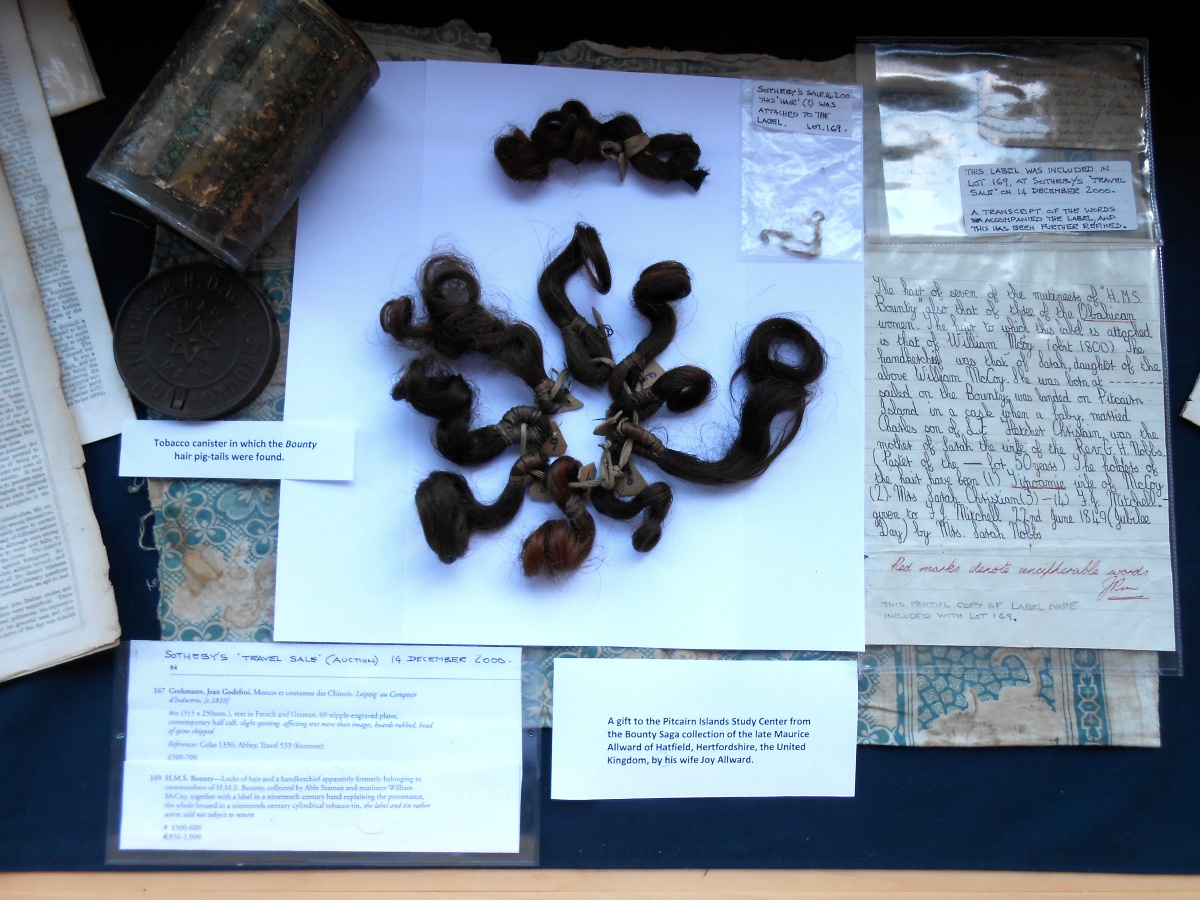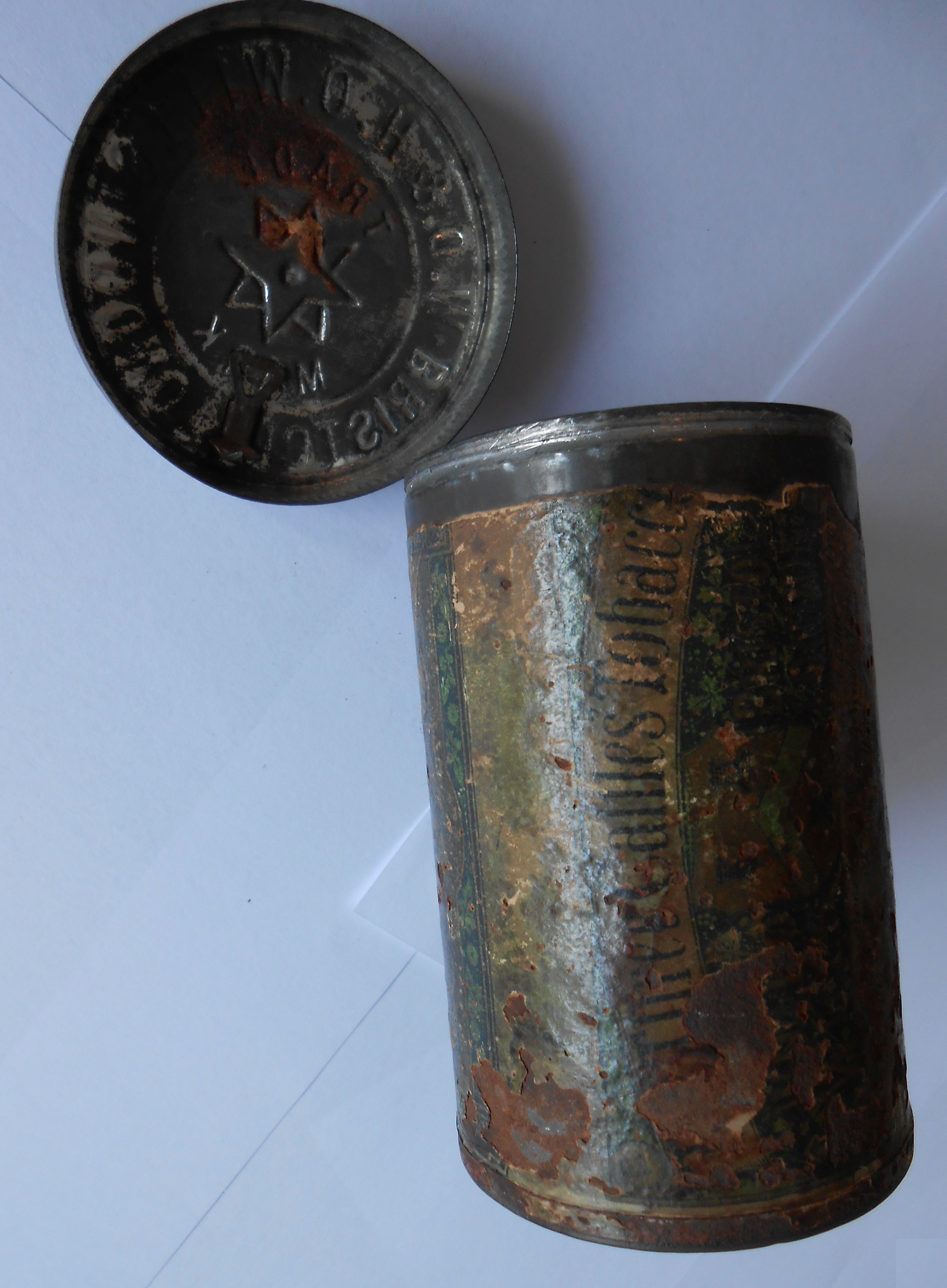Special News Release
The Pitcairn Islands Study Center's Academic
Collaboration with King's College London in
DNA studies of the Center's "Mutineer Hair"
After having received it in a large gift of Bounty-Pitcairn collection items of the late Maurice Allward by his wife Joy, the Pitcairn Islands Study Center in late 2016 entered an academic collaboration with King's College London - one of the world's leading teaching and research universities - to study 10 pigtails of hair thought to be that of seven of the mutineers of H.M.S. Bounty and three of the Polynesian women who accompanied them to Pitcairn Island in 1789.

Pigtails of hair from the collection of pigtails now on display at the Pitcairn Islands
Study in California will be analyzed by forensics experts at King's College London.
The forensic DNA group at King's College London has just received strands of hair from the 10 locks of hair which are on display in the California-based center, located some 70 miles north of San Francisco.
As the pigtails purportedly date back to the pre-1800s, the King's team will first attempt to extract DNA from the historical hair samples after cleaning the outside, and then digesting the hair matrix using a chemical process. Nuclear DNA is not found in hair shafts, only the roots which are not available here; however, mitochondrial DNA may be present. If sufficient mitochondrial DNA can be collected, the first step will be to investigate the ancestral origins of the owners of the pigtails. (See additional study details below line at end of page.)

This 19th century tobacco tin was used to store locks of hair through to be of mutineers of the ship H.M.S. Bounty.
|
"The Study Center's collaboration with King's College London, is an attempt to verify that these locks of hair are authentic, that they are, in fact, the hair of Bounty mutineers and Polynesian women," said Herbert Ford, the Study Center's director.
"There is a fairly good written history about the hair, but we need scientific confirmation if we are to tell visitors who view the hair that it is 'the real thing'." Ford said. "Accuracy and truth are the Study Center's goals, and what we say about these locks of hair is no exception."
The pigtails of hair, stored in a 19th century cylindrical tobacco tin, were obtained by Mr. Allward in a successful bid at a Sotheby's auction in London in 2000. With the hair was a label, attached by twine to one of the pigtails, which, the label said, was attached to the lock of hair of Bounty mutineer William McCoy, who died on Pitcairn Island in 1800.
Also with the locks of hair was an obviously old, beautifully designed handkerchief, said by the label to belong to Sarah, mutineer McCoy's daughter. Sarah, sometimes called "Sully," was not McCoy's biological daughter, but, rather the daughter of McCoy's Polynesian wife Teio, and a Tahitian man. As a 10-month old baby, Sarah was ferried onto Pitcairn Island from the offshore ship Bounty in a barrel.
More contemporary information about the ownership of the hair pigtails comes from V. J. Evans, of the Isle of Wight. In a letter dated June 14, 2001, he writes to Mr. Allward:
"My great grandmother used to sew widths of carpet together to form room-size carpets. She was working at Harrow on the Hill (a northwest suburb of London) in a Professor's house. He could not pay her, so he gave her the items (pigtails of hair and handkerchief) instead. My great grandmother's surname was Bristow. I think she was about 90 years when she died, I was about 5 years. (I am now 63.) My grandmother's surname was Eborn."
"If the tests and genealogical studies of this hair authenticates that it is of seven of the nine mutineers who hid out from British justice on Pitcairn in 1790, it will be the only tangible evidence of their having existed," said Ford. "There is only one known mutineer grave on Pitcairn, that of John Adams. Of the whereabouts of the remains of the eight others we can only speculate."
Ford reiterated that the reason for requesting the collaboration with a world-class research center like King's College London, "is that we want to be very sure we are not traveling under false colors about these hairs. If the research findings tell us the hair is not that of the mutineers, we will stop telling visitors to the Study Center that they are. The Pitcairn Islands Study Center was founded on the requirement that we provide only accurate information about all aspects of The Bounty Saga. This present study seeks to honor that requirement."
The story of the mutiny that took place on the British ship H.M.S. Bounty in the South Pacific Ocean in 1789, was made famous by the publication of a trilogy of books published in the 1930s. Following the publication of the books, five Hollywood-type motion pictures about the mutiny were shown widely worldwide. Even today one of the movies depicting the mutiny may still be seen on television.
The Pitcairn Islands Study Center, established in 1977, is a museum-research facility providing information about the mutiny and its aftermath to academics, journalists, researchers, authors, students, and others throughout the world. The Center holds the world's largest collection of information about this still popular and much-studied sea saga.
King's College London is one of the top 20 universities in the world (2015-16 QS World University Rankings) and among the oldest in England. King's has more than 27,600 students (of whom nearly 10,500 are graduate students) from some 150 countries worldwide, and some 6,800 staff. For more information, visit King's in Brief.
The King's College London team will use a new technique called next generation sequencing to analyze DNA. That is easier said than done. Denise Syndercombe-Court, reader in forensic genetics at King's College and lead scientist on the study, said:
"First, we have to determine whether we can recover mitochrondrial DNA of appropriate quality to be analyzed. The hairs, if from the mutineers, are over 200 years old and we have no idea what environments they might have been exposed to."
Finding a DNA sample to compare it against will be even more difficult. That will involve finding a maternal ancestor of the mutineers, such as their mother or grandmother, or alternatively their sister, and then tracing down through the female line to a living descendant.
"We do not anticipate that this will be easy, and it will require other interested parties to get involved in this part of the study," said Dr. Syndercombe-Court.
###
|





